Spain Plus Two Cities in 2022, Madrid
Parts
Wednesday, September 28
The airport metro station had separate machines for regular tickets and tourist
tickets, and the two tourist machines had their credit card slots taped off,
and one was out of order completely. Fine, I brought plenty of euros with me. A
sign said it would take €50 bills only with a larger purchase than I was
making, but the machine would not take any of my €20 bills. Fortunately, I had
enough small bills and coins to just barely pay the €22.60 for the 4-day pass I
wanted.
 |
| Looking left from front of Hotel Mediodía. |
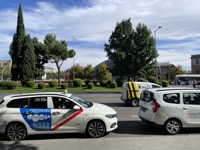 |
| Train station across from Hotel Mediodía. |
After that, the trip into town went well, and my hotel was in sight of the
train station; I was in my room around 14:30, with plenty of daylight left.
Two views from in front of the hotel are to the right. Some people were
photographing the building in the left photo. It houses the ministry of
agriculture, but I do not know what makes the building itself special. On the
right is the train station. The hotels were my favorite part of booking this
trip. I got lucky with hotels near my trains stations, all about 500 meters or
less from the station, and not too expensively priced. It meant I could get
from the train station to the hotel and relax without having to figure out
local transit or navigation first.
I did a quick unpack and headed off to the Hard Rock Cafe for the customary shot
glass for Cathleen. That put me in a shopping area, so I walked around a bit
and scouted a few restaurants Lonely Planet suggested.
Technology and Travel
On this trip, the devices I carried made doing things in a foreign city
much easier than in the past. This is going to sound like an ad for Apple,
but it really was remarkable how helpful technology has become for this.
Apple Maps finds destinations, tells you where a bus stop or train station is,
when the next bus or train is coming, and how many stops to ride. On the bus,
Apple Maps alerts you when you are approaching your stop. I did not have to buy
a map at the train station, look up streets in its index, hunt for them in
their grid squares, locate nearby transit lines, plot routes, interpret transit
schedules, and so no. It is a huge savings of time and effort to just land in a
foreign city and go where you want.
Apple Maps also helps find restaurants and shops and tells you what their
hours are.
The Translate app reads print or cursive and translates conversations with
automatic detection between two languages. With it, I had a richer conversation
with a non-English-speaking store clerk than I did with some people who spoke a
little English. And it translated some museum signs more fluently than the
museum’s translation, with better grammar. Safari translates web pages.
While planning this trip, I used three-dimensional views in Maps to evaluate
hotels and other points of interest, and I added museums, hotels, train
stations, chocolate stores, and other points of interest to Guides for the
cities I was going to. Maps will sort by distance, so as I finished at one
place, I could check what other point of interest to me was nearby.
Apple Pay works many places. Local transit apps provide tickets and schedule
information. My boarding passes and some tickets were in my Apple Watch and
iPhone. I bought museum and transit tickets online, sometimes on the fly.
The compass in my watch helped orient me when coming out of subway stations.
AirTags reassured me I had not left any important items behind.
AT&T has made their international pricing sane and not outrageously priced,
so I had unlimited voice and data without breaking the bank or constantly
monitoring usage and turning off or throttling apps. In addition to helping me
get around, that means I was in ordinary contact with people back home, instead
of being somewhat isolated or off-grid in a foreign country.
And of course the iPhone camera replaced the camera I used to carry. And it is
taking well-adjusted shots. In the past, I took lots of photos hoping to get at
least one with good light and focus, but now I just take a few with different
angles and framing. The lighting, color, and focus usually turn out great with
no work on my part.
The metro trains in Madrid run on the left side, even though automobile traffic
runs on the right side. I had to adjust which way to watch in the stations.
Aside from that, and less-than-optimal signage in Spanish train stations,
getting around in a foreign city is much easier with today’s technology than
when I first lived outside the United States. See the “Technology and Travel”
sidebar.
I continued on my way to visit Cacao Sampaka (enjoyable) and Bombonerias Santa
(not).
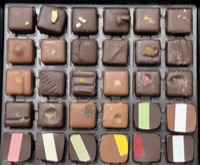 |
| Cacao Sampaka. |
I had prepared lists of restaurants from Lonely Planet, but throughout
the trip, I did not find Lonely Planet’s suggestions very useful, with a
few exceptions. Apple Maps and TripAdvisor (incorporated into Maps) were a
better resource. For dinner, they found me Los Porfiados de Lavapiés. I got
there shortly after opening and had the dish you see below, between pictures of
the street the restaurant is on, taken before or after dinner.
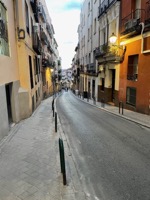 |
| Calle Buenavista, en route to Los Porfiados. |
 |
| Chicken breaded in cornflakes, with tartar sauce, flavored soy, cucumber and apple at Los Porfiados. |
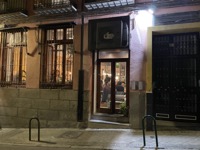 |
| Los Porfiados. |
 |
| Los Porfiados from up the street. |
I took the picture on the left because I thought the view was nice and only
realized later that the people who named the street (“Buenavista”) agree with
me.
Thursday September 29
I started Thursday at Thyssen-Bornemisza Museo Nacional. The photo on the left,
below, struck me because I recognized that location. Just a bit surprising, not
really unexpected when you think about it, to see an old fine-art painting of a
place I know from modern times. The middle painting is a Magritte I do not
recall seeing before, not even at the Magritte museum in Bruxelles. The right
photo is for a friend who is into pinball. The museum also had an American wing
with paintings from exotic far-away Boston and Gloucester.
 |
| 1724 painting of St. Mark’s Square in Venice. |
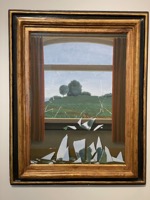 |
| Magritte at Museo Thyssen-Bornemisza. |
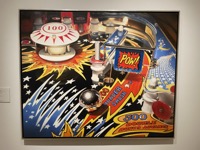 |
| Pinball painting. |
For lunch, I went to Bodega de los Secretos, also found thanks to Apple Maps
and TripAdvisor. Bodega de los Secretos is underground. From their menu:
In Bodega de los Secretos four centuries of history have left plenty of
Secrets. In the 17th century this area of Madrid was surrounded by
vineyards, perfect place for a wine cellar. The maze of the galleries makes you
feel like you were in a Romanesque Cloister. At that time, monks used to
elaborate wine, that’s why this cellar belonged to the congregation of San
Felipe de Neri. In 1808 Napoleon’s troops failed to find people from Madrid
hidden in this secret cellar. Along the Spanish Civil War this was a “bomb
shelter.” Last two wars in Madrid left us a secret escape tunel that still you
can see in our main room.
 |
| Creamy ham croquettes. |
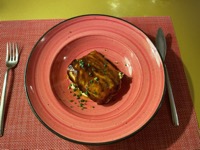 |
| Cod au gratin with pear aioli. |
 |
| Bodega de los Secretos. |
The fact it is below ground means you should make a note of the Wi-Fi password
on their menu, because you will not have cellular service. Fortunately, I
downloaded the language packages in Apple Translate before going on this trip,
so that worked even without a network connection.
This and Los Porfiados may have been the best meals I had this trip. Also, this
meal was early for lunch in Spain, near 2 p.m. Last night’s dinner was just at
the start of the restaurant’s dinner service, at 8 p.m., and when I left around
9 p.m., the restaurant was filling up. I did not get used to Spain’s meal times
during this trip.
In the afternoon, I visited the archeological museum, the Apple Store, and
Bomboneria La Pajarita. La Pajarita is the oldest chocolate shop in Madrid,
founded in 1852. Unfortunately, that may be the only reason to go there. I
discarded a little under half of the chocolates I bought there; they were not
worth finishing. For dinner, I went to Aloha Poke. (I have to wonder why the
Aloha Poke receipt says “Thank you for visiting our city.” Do residents not eat
there? Is that a receipt just for tourists? Hmm, it is also on a receipt from
an unrelated place in Barcelona except the payment processor is the same. Maybe
they print it for foreign credit cards?)
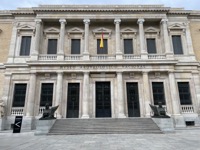 |
| Museo Arqueológico Nacional. |
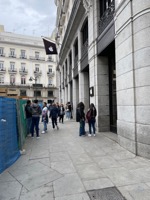 |
| Apple Store in Madrid. |
Friday, September 30
 |
| Oriol Balaguer 2022-09-30. |
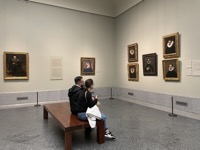 |
| Buste de Femme 43 at Museo del Prado. |
I had a Museo del Prado reservation for 14:00, so that left my morning free
for important work, surveying more chocolate stores. I visited Oriol Balaguer,
Mon Chocolate, and Chocolat Factory. Oriol Balaguer is mostly a fancy pastry
shop but they had a few chocolates that were nice but more expensive than they
were worth. Mon Chocolate was a small store with a few brands of chocolate.
Chocolat Factory is a chain. Unfortunately, I was chocolated out and could not
sample them. By looks, I might guess on a par with Neuhaus.
I spent 3½ hours at the Prado. So I was museumed out. The museum was mostly
paintings of religious scenes or wealthy people from the 1700s and 1800s.
There was exactly one painting that was different from every other one on
display. You can see it in the picture to the right.
Saturday, October 1
Saturday I went to the Royal Palace of Madrid for a tour. Adjacent to the
palace is a large park that was a royal estate from the 1500s to 1931.
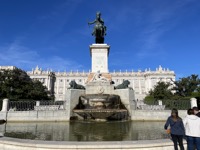 |
| Plaze de Oriente with royal palace in background. |
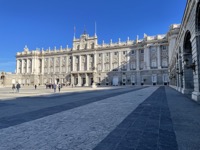 |
| Royal Palace of Madrid. |
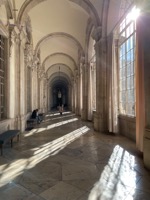 |
| Royal Palace of Madrid. |
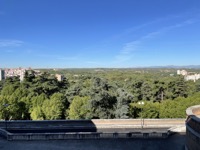 |
| View from Royal Palace of Madrid. |
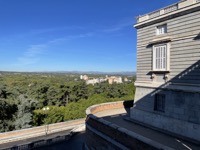 |
| View from Royal Palace of Madrid. |
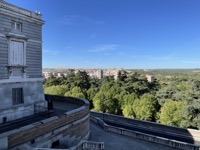 |
| View from Royal Palace of Madrid. |
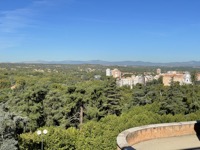 |
| View from Royal Palace of Madrid. |
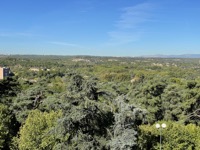 |
| View from Royal Palace of Madrid. |
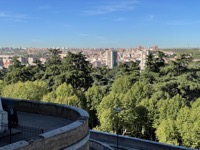 |
| View from Royal Palace of Madrid. |
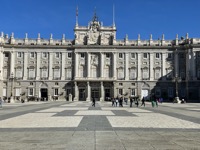 |
| Royal Palace of Madrid. |
After the palace, I explored the area briefly. The walls in the
Muslim Walls
photographs date to the ninth century.
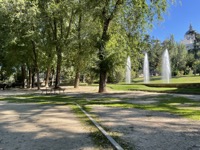 |
| Park near Royal Palace. |
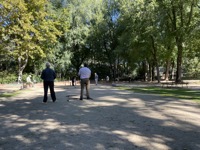 |
| Park near Royal Palace. |
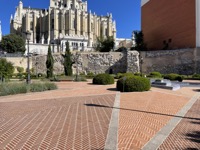 |
| Muslim Walls. |
 |
| Muslim Walls. |
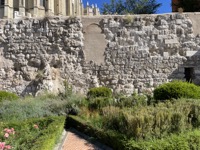 |
| Muslim Walls. |
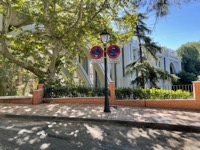 |
| Bridge near Royal Palace. |
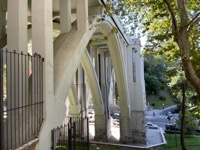 |
| Bridge near Royal Palace. |
 |
| Street. |
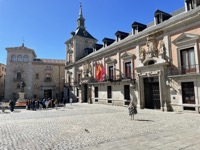 |
| Plaza de la Villa. |
 |
| Plaza de la Villa. |
 |
| Plaza de la Villa. |
 |
| Plaza de la Villa. |
 |
| Spanish take on tacos. |
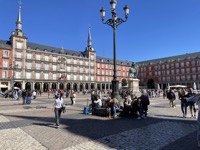 |
| Plaza Mayor. |
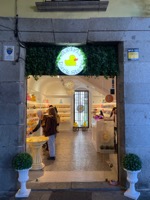 |
| Rubber duck store in Madrid. |
Mercado de San Miguel is a building with numerous food stalls. Think Quincy
Market but bigger or Reading Terminal Market but smaller. At Taco Sam, I found
these tacos, Bacon Cheese Pork on left, Shrimp Curry-Mango on right.
Mercado de San Miguel is near Plaza Mayor, a large square surrounding by
buildings, including cafes. Lonely Planet suggested an arts and crafts store
here, but it was gone. In its place, I found a rubber duck store. They have all
kinds of ducks: celebrity ducks, fictional character ducks, occupation ducks,
and more.
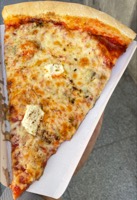 |
| Four cheese pizza from Carpasso. |
The tacos were not enough with all the walking I was doing, so I grabbed a
slice of pizza on the way back to the hotel. (I kept looking for tapas and
paella, but the offerings are not great for a solo traveler and sometimes look
inflated for tourists. I tried some options during the trip but did not find
them remarkable, except the croquettes at the first two restaurants were pretty
good.)
Setting out again, I passed through Park de El
Retiro, a large park (350 acres) near the middle of the city.
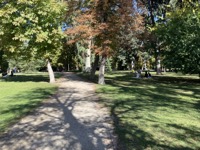 |
| Parque de El Retiro. |
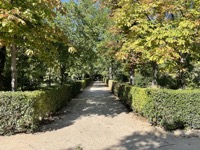 |
| Parque de El Retiro. |
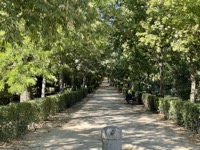 |
| Parque de El Retiro. |
 |
| Parque de El Retiro. |
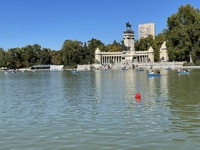 |
| Parque de El Retiro. |
 |
| Parque de El Retiro. |
Then I headed for a bistro to check off one of the must-try items in Spain,
paella. Hmm, okay, it is rice with stuff, so?
Finally, to end the day, I visited Estación de
Chamberí, a defunct subway station. It was in service from 1919 to 1966.
Trains still pass through it, without stopping. The wait to get in was the
longest wait I had to get into any museum or attraction this trip. One thing
they mentioned on the tour was the early advertisements in the station were
done in tile, making it hard to change for new advertisers, and it was only
later they switched to paper.
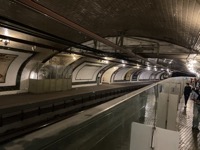 |
| Estación de Chamberí. |
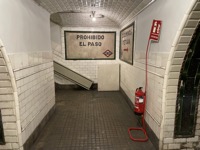 |
| Estación de Chamberí. |
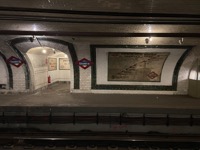 |
| Estación de Chamberí. |
 |
| Estación de Chamberí. |
Sunday, October 2
Time to leave Madrid. Here is a photo in the train station. To tick off another
Spanish food, I had some empanadas while waiting for my train.
 |
| Madrid Puerta de Atocha. |
© Copyright 2022 by
Eric Postpischil.















































